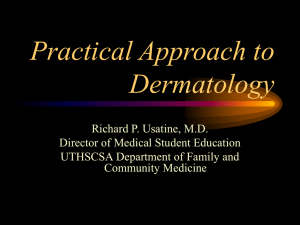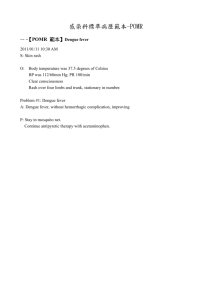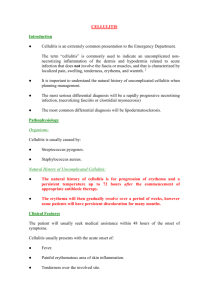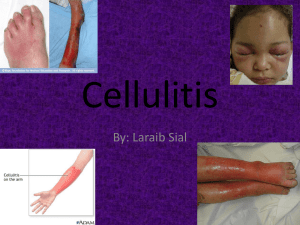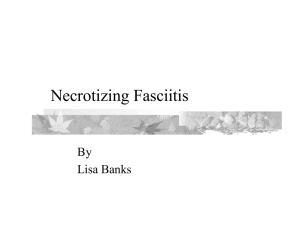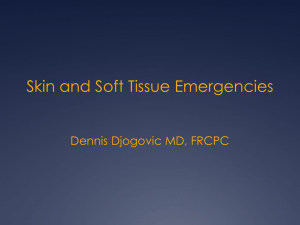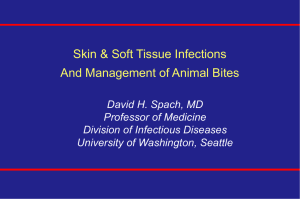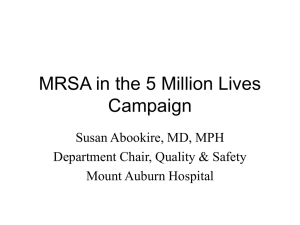Cellulitis - UNM Internal Medicine Resident Wiki
advertisement
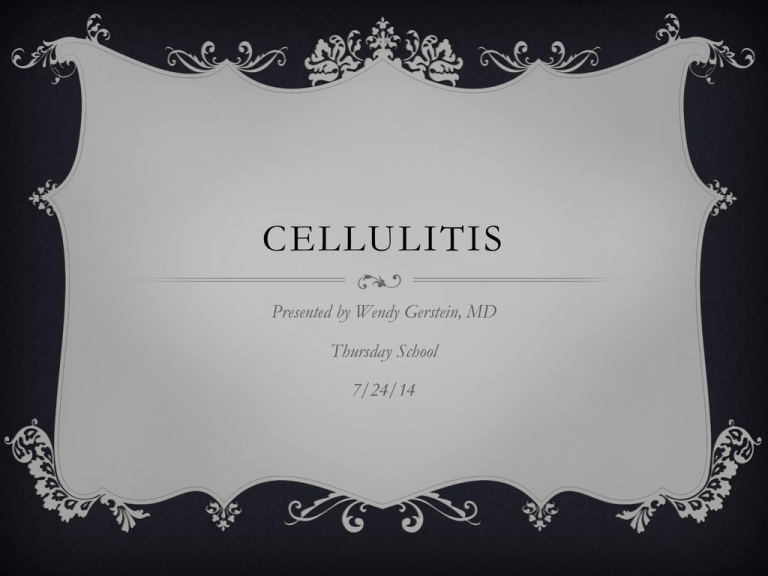
CELLULITIS Presented by Wendy Gerstein, MD Thursday School 7/24/14 QUESTION 1 38 yo woman is evaluated in urgent care for redness and pus that developed near a scratch on her right shin. On PE: T=37.3 C, bp 135/75, p 78, rr 14. A 3x2 cm erythematous, warm patch is present over the right shin with associated purulence/pus, but no fluctuance, drainable abscess or lymphadenopathy is present. WBC is 10k with 70% N and 30% L. She has no drug allergies. Which of the following is the most appropriate outpatient therapy? • • • • A) Cephalexin (Keflex) B) Dicloxacillin C) Trimethoprim-sulfamethoxazole (Bactrim) D) Amoxicillin QUESTION 2 A 27 yo male is evaluated for redness that developed over his left forearm at the site of a mosquito bite. He is otherwise healthy and takes no medications. PE: T= 37.2 C, bp 120/70, p 68, rr 14. There is an erythematous 3x3 cm patch on the left forearm. The area is warm to the touch with no evidence of purulence, fluctuance, crepitus, or lymphadenopathy. Which of the following is the most appropriate empiric outpatient therapy? • • • • • A) Doxycycline B) Cephalexin (Keflex) C) Fluconazole D) Trimethoprim-sulfamethoxazole (Bactrim) E) Metronidazole ANSWERS Answer for question 1: C, Bactrim Answer for question 2: B, Cephalexin (Keflex) What is the one important difference between the two cases? CELLULITIS CELLULITIS Clinical presentation: local tenderness, pain and erythema that rapidly increases. Borders are not elevated or sharply demarcated (as in erysipelas). May have patchy involvement with skip areas. Systemic manifestations include mild fever, chills and malaise, can progress to sepsis. CELLULITIS Complications can include bacteremia, abscesses, overlying skin necrosis, muscle/joint/bone involvement. Risk factors: lymphedema, chronic venous stasis, trauma, skin breakdown (fungal infection), diabetes, immunosuppression, altered anatomy/surgery. Patient who are showing systemic signs (i.e., meet SIRS criteria) should be admitted for initial treatment with IV antibiotics, then transition to appropriate oral therapy. ORGANISMS Most common organisms: streptococci (group A β-hemolytic [GABHS] most likely) and Staphylococcus aureus. Think strep if “peau d’orange” skin changes and lymphangitis are present. Think S. aureus (and CA-MRSA, MRSA) if purulence or abscess present. Erysipelas: superficial, well-demarcated, intensely erythematous, indurated borders. GABHS. CELLULITIS Post-operative infections with Group A strep are uncommon but can spread rapidly and develop into bacteremia/sepsis. Can occur within 6-48 hours after surgery. • Hypotension may be the first signs of infection prior to cellulitis. • Thin serous discharge may be expressed from the surgical site that is gram stain positive for streptococci. CELLULITIS Diabetics: at risk for polymicrobial infections including: • GPC including S. aureus, Enterococcus, various streptococcal species, peptostreptococcus (anaerobe). • GN aerobes: Enterobacter, Acinetobacter, and Pseudomonas. • GN anaerobes: Bacteroides ANTIBIOTICS IN CELLULITIS At minimum, need empiric coverage for strep species and S. aureus. Include a β-lactam antibiotic with activity against penicillinaseproducing S. aureus (MSSA). If not severe may treat as outpatient. • Cephalexin or dicloxacillin have good strep and MSSA coverage. • Clindamycin may be used for strep and CA-MRSA (know local antibiogram). • If suspect MRSA then consider TMP-SMX or doxycycline (can add clindamycin or amoxillin if need improved strep coverage). May also consider Linezolid. ANTIBIOTICS CONT. Inpatient antibiotic choices: • Strep/MSSA choices: nafcillin, cefazolin, clindamycin • CA-MRSA/MRSA: clindamycin (know antibiogram), vancomycin, daptomycin, linezolid, ceftaroline. • Diabetics: broaden to amp-sulbactam (moderate infection), pip/tazobactam (severe) plus MRSA coverage. Remember ceftriaxone does not have anaerobic coverage. • Septic patient: start broad, then narrow coverage as cultures return. CA-MRSA/MRSA MRSA CELLULITIS GUIDELINES For a cutaneous abscess incision and drainage is the primary treatment. When is adjunct antibiotic therapy recommend for abscesses? • Severe or extensive (multiple sites) or rapid progression in presence of cellulitis. • Signs of systemic illness. • Associated comorbidities or immunosuppressed. • Extremes of age. MRSA CELLULITIS GUIDELINES • Abscess in area difficult to drain (face, hand and genitalia). • Associated with septic phlebitis. • Lack of response to incision and drainage. MRSA CELLULITIS GUIDELINES Treatment of purulent cellulitis: • • • • Empiric treatment for CA-MRSA/MRSA. Bactrim, clindamycin, doxycycline or minocycline, linezolid. If need MRSA and streptococcus coverage: clindamycin; or bactrim or doxycycline with amoxicillin; or linezolid alone. If inpatient treat with IV antibiotics initially: vancomycin, clindamycin, linezolid, daptomycin, ceftaroline. AJM 2010;123:942-950 Retrospective cohort study in 2005-2007 comparing bactrim to cephalexin to clindamycin for mild to moderate cellulitis. 405 patients in study: • Excluded patients with severe cellulitis. • MRSA recovered in 72/117 positive culture specimens. • Successful treatment • TMP-SMX 138/152 (91%) • Cephalexin 134/180 (74%) • Clindamycin 34/40 (85%) HOW LONG TO TREAT?? IDSA guidelines: five days of treatment is a effective as a 10 day course for uncomplicated cellulitis. Based on a 2004 study in which 87 patients were treated with levofloxacin 500mg po qd x 5 days compared with 43 patients who received levofloxacin for 10 days. Complete resolution on day 14 was similar and day 28 recurrence rate was similar. However levofloxacin has a longer ½ life than β-lactam antibiotics that are used more commonly. IDSA recommends evaluation at day 5 – if resolved can stop antibiotics. If persisting, continue to 10 days. Arch Intern Med 2004;164:1169-1674. P RO P H Y L A X I S F O R R E C U R R E N T C E L LU L I T I S First identify and treat predisposing conditions (edema, obesity, eczema, venous insufficiency, fungal foot infections). Oral penicillin 250-500 mg po bid for one year should be considered in patients who have >3 episodes per year despite attempts to treat or control predisposing factors. Can continue past one year (indefinitely) if factors persist and patient tolerating. IDSA guidelines, 2014. Based on two studies, PATCH 1 and PATCH 2. SPECIAL CIRCUMSTANCES FOR CELLULITIS Erysipelothrix rhusiopathiae (erysipeloid) – gram positive facultative anaerobic rod. Causes an indolent cellulitis occurring in persons who handle saltwater fish, shellfish, poultry, meat and hides. Treat with penicillin or cephalosporin. Aeromonas hydrophila – gram negative rod that causes an acute cellulitis after laceration while swimming in fresh water. Also associated with medicinal leeches. Treat with ciprofloxacin +/doxycycline. SPECIAL CIRCUMSTANCES FOR CELLULITIS Vibrio vulnificus (curved gram negative rod) causes cellulitis, bullous lesions or necrotic ulcers after exposure to warm coastal water or exposure to drippings from raw seafood. Infection can progress to necrosis requiring surgical debridement. • Bacteremia with septicemia can occur after eating raw oysters, can develop associated skin findings. • Alcoholic cirrhosis, hemochromatosis and thalassemia increase the risk of septicemia and development of necrotizing fasciitis (due to iron overload). • Treat with doxycycline plus ceftriaxone. E . R H U S I O PA T H I A E A N D V I B R I O E. rhusiopathiae Vibrio species OTHER Animal or human bite: • Clean wound, check tetanus status of patient, rabies status of animal. • Usually polymicrobial infection due to mouth and skin flora. • Empiric antibiotic coverage with Augmentin or unasyn. • Penicillin allergic : fluoroquinolone or doxycycline (plus clindamycin or metronidazole for anaerobic coverage). Drugs 2003;63:1459-1480 IMMUNOSUPPRESSED (CANCER PAT I E N T S, A I D S, T R A N S P L A N T ) Differential for skin lesions much broader in this subset – biopsy is necessary is most cases, get early if possible. Need to consider infection, drug reaction/eruption, Sweet syndrome, malignancy, leukocytoclastic vasculitis, erythema multiforme. QUESTION 3 40 yo male evaluated in ER for LUE skin infection. He works at the VA, where he sustained a minor laceration 3 days ago when trying to prevent a patient’s fall. He cleaned and bandaged the laceration but developed purulence, surrounding tenderness, and now with fever over last 24 hours. On exam T=38.5, bp 125/75, p 90, rr 18. An area of purulent cellulitis measuring 4x5 cm surrounding a 1.5 cm laceration is present. No fluctuance. Rest of exam wnl. WBC 14k, 90% neutrophils. UA nl. Radiograph of arm only shows soft tissue swelling. QUESTION 3 CONTINUED Which of the following beta-lactam antibiotics is most appropriate for treatment of this infection? • • • • • A) Meropenem B) Oxacillin C) Zosyn (pip/tazobactam) D) Ceftaroline E) Ceftriaxone QU E S T I O N 3 C O N T I N U E D Correct answer is D, ceftaroline – need MRSA coverage due to purulence, health-care associated. Vancomycin would have been correct if offered as a choice. NECROTIZING FASCIITIS Deep tissue infection that spreads rapidly along fascial planes. Clinical features that suggest a necrotizing infection include: • Severe constant pain, pain out of proportion to exam. • Bullae: related to occlusion of deep blood vessels that traverse the fascia or muscles. • Skin necrosis or ecchymosis that precedes the skin necrosis. • Gas in the soft tissues. • Edema that extends beyond the margin of the erythema. • Cutaneous anesthesia. • Systemic toxicity (fever, leukocytosis, delirium, renal failure). • Rapid spread, especially concerning if on antibiotic therapy. • Subcutaneous tissues feels wooden-hard. NECROTIZING FASCIITIS NECROTIZING FASCIITIS NECROTIZING FASCIITIS Type I- Polymicrobial • Includes at least one anaerobic species, commonly Bacteroides or Peptostreptococcus; • Plus one or more facultative anaerobic species such as streptococci; • Plus members of Enterobacteriaceae (E. coli, Enterobacter, Klebsiella, Proteus. • Associated with: • Surgical procedures involving the bowel or penetrating abdominal trauma. • Decubitus ulcer or a perianal abscess. • Site of injection in IVDA. • Spread from a Bartholin abscess or minor vulvovaginal infection. NECROTIZING FASCIITIS Type II (aka hemolytic streptococcal gangrene): Group A streptococci are isolated either alone or with S. aureus • Usually involves the limbs with 2/3 in the lower extremities. • Associated with underlying disease: • • • • • DM Arteriosclerotic vascular disease Venous insufficiency with edema Chronic vascular ulcer Post varicella infection – commonly due to S. pyogenes • Mortality is high- 50-70% in patients with hypotension and organ failure. Lancet 1994;344:1111-5 NECROTIZING FASCIITIS Type III- Gram negative monomicrobial • Vibrio spp • V. damselae and V. vulnificus • Mortality of 30-40% despite prompt diagnosis and aggressive therapy. (J of Hos Infec 2010;75:249-257) Type IV- Fungal • Cases of candida NF very rare, mostly in immunocompromised. • Zygomycotic NF (Mucor and Rhizopus spp) affect immunocompetent patients after severe trauma. • Burns or trauma wounds with aspergillus or zygomycetes should be consider infected (not just colonized). (J of Hos Infec 2010;75:249257 NECROTIZING FASCIITIS Determinants of mortality • Retrospective study in 2005 in Taiwan. • Studied both type I and type II necrotizing fasciitis. • 87 pts. Found increased mortality with: • Age >60 • 2 comorbidities, especially DM and liver disease • Thrombocytopenia • Abnormal liver function tests • Increased BUN and Cr • Low serum albumin level • Patients who underwent emergent debridement in <24 hours had a lower mortality than patients whose surgery was delayed (26% vs 45.9%). • Total of 30/87 patients died in this study (34.4%). • J Micro Imm Infect 2005;38:430-435 NECROTIZING FASCIITIS Studies • CT scan or MRI may show edema and/or gas extending along the fascial plane. • In practice, clinical judgment is the most important element of diagnosis. • Cultures obtained from deep tissue during surgery are helpful. • Skin cultures usually contaminated with skin flora. NECROTIZING FASCIITIS Treatment: • Surgical intervention: • No response to antibiotic therapy. • Profound toxicity with fever, hypotension, or advancement of skin and soft-tissue infection during antibiotic therapy. • Local wound shows any necrosis with easy dissection along fascia by blunt instrument. • Any soft tissue infection accompanied by gas. • Most patients with necrotizing fasciitis should return to the OR within 24-36 hours after first debridement and daily thereafter until surgical team finds no further need for debridement. NECROTIZING FASCIITIS Empiric coverage: very broad • Piperacillin-tazobactam , plus vancomycin OR • Meropenem/imipenem plus vancomycin. • PCN allergy: Cefotaxime, plus metronidazole or clindamycin, plus vancomycin. • Severe PCN allergy: clindamycin or metronidazole, plus aminoglycoside or fluoroquinolone, plus vancomycin. NECROTIZING FASCIITIS Streptococci infections • PCN: most streptococci are susceptible in the US. • Clindamycin: in vitro studies demonstrate both toxin suppression and modulation of cytokine TNF production. • Give both initially. NECROTIZING FASCIITIS IVIG – not enough evidence to recommend therapy. HBO – hyperbaric oxygen – not enough evidence to recommend therapy. Questions…
